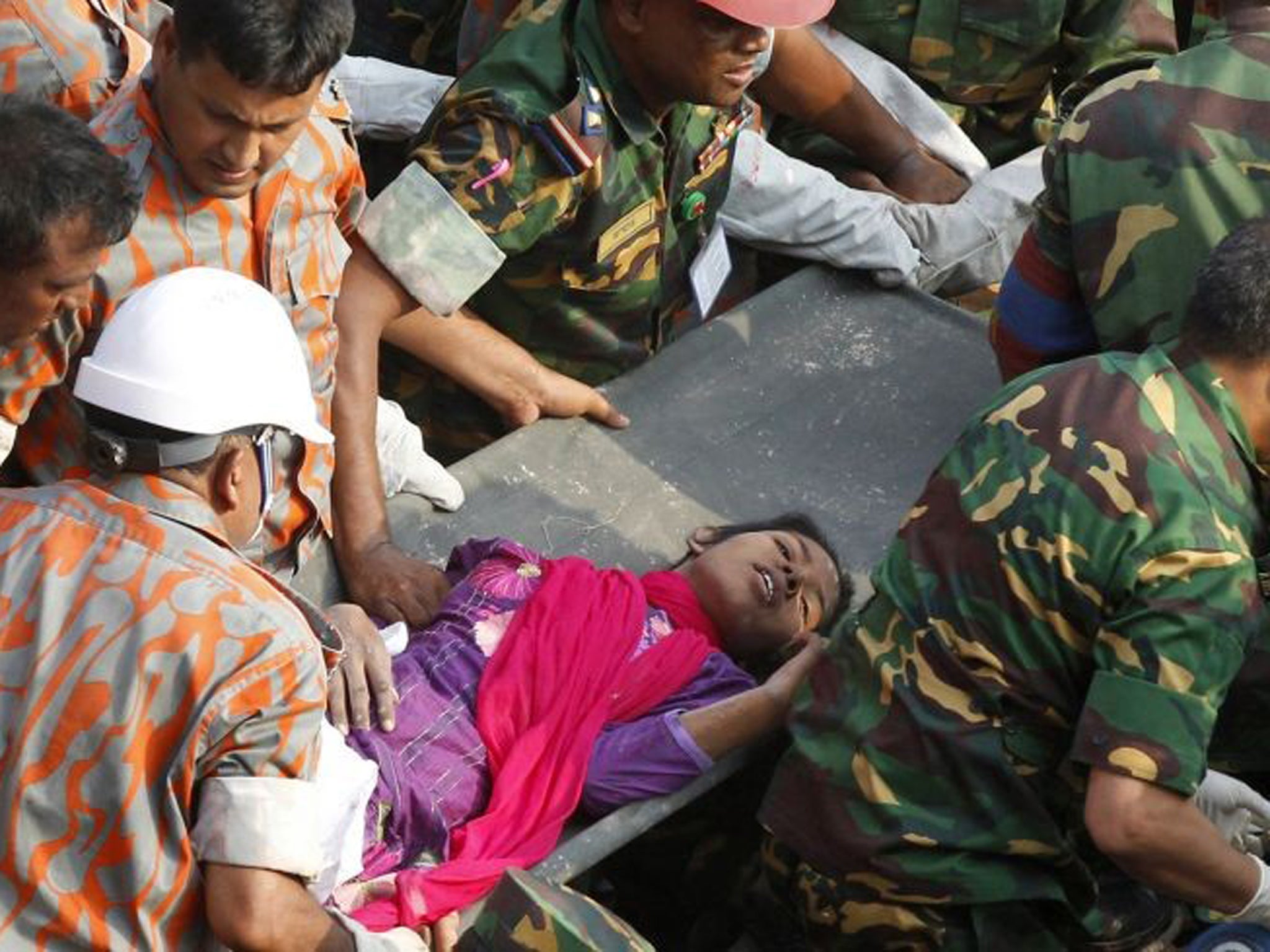'I never dreamed I'd see the daylight again': a joyful end to Reshma’s 17-day – but death toll in Dhaka clothing factory collapse in Bangladesh goes past 1,000
Rescuers free a woman as the latest death toll reaches above 1,000

Your support helps us to tell the story
From reproductive rights to climate change to Big Tech, The Independent is on the ground when the story is developing. Whether it's investigating the financials of Elon Musk's pro-Trump PAC or producing our latest documentary, 'The A Word', which shines a light on the American women fighting for reproductive rights, we know how important it is to parse out the facts from the messaging.
At such a critical moment in US history, we need reporters on the ground. Your donation allows us to keep sending journalists to speak to both sides of the story.
The Independent is trusted by Americans across the entire political spectrum. And unlike many other quality news outlets, we choose not to lock Americans out of our reporting and analysis with paywalls. We believe quality journalism should be available to everyone, paid for by those who can afford it.
Your support makes all the difference.To be buried alive, to hear the voices of the living but to be unable to make them hear you: for much of this week, already entombed for a fortnight, that was the nightmare endured by Reshma, the Bangladeshi woman miraculously pulled out of the ruins of Rana Plaza on the outskirts of Dhaka afternoon, where at least 1,043 of her co-workers have died, a figure that is likely to climb further.
“I heard the voices of the rescue workers for the past several days,” she said from the hospital where she was recovering. “I kept hitting the wreckage with sticks and rods to attract their attention. No one heard me. I never dreamed I’d see the daylight again.”
As cranes and earthmovers smashed through the concrete and steel rods in the ruins of the nine-storey building yesterday, Bangladesh’s worst-ever building collapse became the worst industrial accident in the world since the Bhopal gas disaster of 1984.
The bodies hauled from the wreckage now were so badly decomposed as to be unidentifiable. No one had been found alive since 28 April, and that last find ended in tragedy when sparks from the rescuer’s power saw started a fire that killed both him and the trapped woman.
So why imagine, prior to smashing another slab of concrete, that today could be different? But the usual precautions were taken. And then the miracle happened. “As we made an announcement before starting to break the slab asking whether there was anyone alive in there, we heard someone groan,” a worker told Dhaka’s Daily Star. They called out to her, asking if she was badly hurt. “Not much,” she replied. What was her name? “Reshma,” came the feeble voice.
Immediately the cranes and bulldozers were ordered to stop work. As the rescuers inched nearer with handsaws and drills, words of supplication came over the loudspeakers. “Allah, you are the greatest. Please allow us to rescue the survivor just found.” This was Friday, the day of prayer, and Reshma had survived for 17 days in the building’s prayer room. “We ask pardon for our sins,” came the voice through the loudspeaker. “Please pardon us, pardon the person found alive.”
As the men drew closer, the trapped woman waggled a pipe to indicate her location. “We first saw a pipe moving,” said rescuer Major Moazzem. “We removed some gravel and concrete. We found her standing.” After her uniquely long ordeal, Reshma was not only alive but well. Ahmed Ali, chief of Bangladesh’s fire service, explained that she was found in a gap between a beam and a column. “She was fine, no injuries,” another army officer, Colonel Moyeen, said. “The space was wide.”
As her rescuers passed her water, biscuits, oxygen and saline, Reshma chatted with them. When she was freed after 40 minutes, the site erupted in cheers. Hauled out on a stretcher in her mauve sari, she managed a weak smile for her rescuers.
Bangladesh’s Prime Minister Sheikh Hasina, under fierce attack for her government’s failure to ensure the safety of its workforce – eight more people died in a factory fire earlier this week – seized on this crumb of mercy. When they spoke on the telephone, Reshma burst into tears then said: “I am fine, please pray for me.”
Speaking from hospital, Reshma explained how she had survived: “There was some dried food around me. I ate the dried food for 15 days. The last two days I had nothing but water.” Major General Chowdhury Hasan Suhrawardy, head of local military units, told reporters: “Reshma told me there were three others with her. They died. We will continue our search.”
Staying alive: Stories of survival
Forty-year-old Naqsha Bibi survived 63 days buried in the remains of her kitchen in Pakistan-administered Kashmir following a massive earthquake in 2005. She survived on rotten food and water trickling in from a stream, and weighed just 35kg when she was found.
Rice seller Evans Monsignac was trapped for 27 days after a 2010 earthquake flattened Port-au-Prince in Haiti. Unable to move, he survived by drinking sewage that flowed beneath his feet in the rubble.
Park Seung Hyun survived on rainwater for 16 days after a South Korean department store collapsed in 1995, killing 502 people.
Pedrito Dy spent 14 days under the rubble of a hotel in the Philippines, following an earthquake in 1990.
Oscar Quine
Join our commenting forum
Join thought-provoking conversations, follow other Independent readers and see their replies
Comments